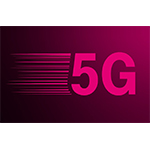 T-Mobile said today that it has turned up 5G service using mid-band spectrum in parts of three more markets – Chicago, Houston and Los Angeles. In a blog post about T-Mobile mid-band 5G and other 5G developments, T-Mobile President of Technology Neville Ray also said T-Mobile has seen peak speeds of 1,200 Mbps with mid-band 5G, which already has been deployed in Philadelphia and New York.
T-Mobile said today that it has turned up 5G service using mid-band spectrum in parts of three more markets – Chicago, Houston and Los Angeles. In a blog post about T-Mobile mid-band 5G and other 5G developments, T-Mobile President of Technology Neville Ray also said T-Mobile has seen peak speeds of 1,200 Mbps with mid-band 5G, which already has been deployed in Philadelphia and New York.
Average download speeds exceed 300 Mbps on the mid-band 5G network, according to T-Mobile. Other news in Ray’s blog post: T-Mobile is opening up its fixed wireless service, now known as T-Mobile Home Internet, to non-T-Mobile customers for the first time.
The blog post also reiterated other recent T-Mobile 5G developments, including several involving standalone 5G. Ray noted that the company has completed what he called the “world’s first standalone 5G data session on a multi-vendor radio and core network” and “the first standalone 5G data session of any kind in North America.”
T-Mobile Mid-Band 5G
One of the prizes that T-Mobile won through its purchase of Sprint, completed earlier this year, was Sprint’s broad and deep spectrum holdings in the 2.5 GHz band. In his blog post, Ray noted that other carriers are adopting T-Mobile’s “layer cake” approach to 5G that involves using low-frequency or low-band spectrum for coverage, with high-frequency millimeter wave bands providing peak speeds and mid-band 5G spectrum offering a trade-off between range and speed.

T-Mobile announced plans to deploy 5G initially using low-band spectrum back in 2017 and as Ray noted, “back then everyone was following Verizon’s lead and betting on millimeter wave as the cornerstone of 5G. In the ensuing years, everyone . . . has changed their tune and embraced the ‘layer cake’ approach we pioneered, using all spectrum bands for 5G.”
Deploying 5G initially using low-band 600 MHz spectrum has enabled T-Mobile to tout broader network coverage. According to Ray, the company recently completed the world’s “farthest-ever 5G connection” – 60 miles from the base station.
Fixed Wireless
T-Mobile made promises about its fixed wireless offering, now known as T-Mobile Home Internet, as a condition of regulatory approval of its merger with Sprint. In today’s blog post about T-Mobile mid-band 5G and more, Ray noted that the company plans to offer T-Mobile Home Internet in more than 50% of U.S. zip codes but did not specify a deadline for completion.
The company recently revealed that T-Mobile Home Internet has been undergoing trials in Grand Rapids, Michigan but the company hasn’t revealed any other markets where it is building out or plans to build out service, other than communities neighboring Grand Rapids.
Standalone 5G
Unlike the earliest 5G deployments, standalone 5G does not rely on underlying previous-generation network technology. As Ray explained in his blog post, it will “pave the way for applications that require real-time responses and massive connectivity such as mobile augmented and virtual reality, cloud gaming, smart factories and meters and even connected vehicles.
